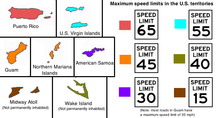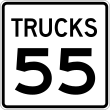

In the United States, speed limits are set by each state or territory. States have also allowed counties and municipalities to enact typically lower limits. Highway speed limits can range from an urban low of 25 mph (40 km/h) to a rural high of 85 mph (137 km/h). Speed limits are typically posted in increments of five miles per hour (8 km/h). Some states have lower limits for trucks, some also have night and/or minimum speed limits.
The highest speed limits are generally 70 mph (113 km/h) on the West Coast and the inland eastern states, 75–80 mph (121–129 km/h) in inland western states, along with Arkansas, Louisiana, Maine, and Michigan; and 65–70 mph (105–113 km/h) on the Eastern Seaboard. Alaska, Connecticut, Delaware, Massachusetts, New Jersey, New York,[1] Puerto Rico, Rhode Island, and Vermont have a maximum limit of 65 mph (105 km/h), and Hawaii has a maximum limit of 60 mph (97 km/h). The District of Columbia and the U.S. Virgin Islands have a maximum speed limit of 55 mph (89 km/h). Guam and the Northern Mariana Islands have speed limits of 45 mph (72 km/h). American Samoa has a maximum speed limit of 30 mph (48 km/h).[2] Two territories in the U.S. Minor Outlying Islands have their own speed limits: 40 mph (64 km/h) in Wake Island, and 15 mph (24 km/h) in Midway Atoll.[3][4] Unusual for any state east of the Mississippi River, much of Interstate 95 (I-95) in Maine north of Bangor allows up to 75 mph (121 km/h), and the same is true for up to 600 mi (966 km) of freeways in Michigan. Portions of the Idaho, Montana, Nevada, Oklahoma, South Dakota, Texas, Utah, and Wyoming road networks have 80 mph (129 km/h) posted limits. The highest posted speed limit in the country is 85 mph (137 km/h) and can be found only on Texas State Highway 130, a toll road that bypasses the Austin metropolitan area for long-distance traffic.
During World War II, the U.S. Office of Defense Transportation established a national 35 mph "Victory Speed Limit" (also known as "War Speed") to conserve gasoline and rubber for the American war effort,[5] from May 1942 to August 1945, when the war ended. For 13 years (January 1974[6]–April 1987[7][8]), federal law withheld Federal highway trust funds to states that had speed limits above 55 mph (89 km/h).[7] From April 1987 to December 8, 1995, an amended federal law allowed speed limits up to 65 mph (105 km/h) on rural Interstate and rural roads built to Interstate highway standards.

- ^ "Speeding & Speed Limits Index & Overview". www.safeny.ny.gov. Retrieved March 21, 2019.
- ^ http://www.asbar.org/index.php?option=com_content&view=category&id=583&Itemid=172 Asbar.org. Title 22 - Highways and Motor Vehicles. Chapter 03 - Rules of the Road. Retrieved July 7, 2019.
- ^ Cite error: The named reference
Wakewas invoked but never defined (see the help page). - ^ Midway Atoll Code
- ^ Flamm, Bradley (2006). "Putting the brakes on 'non-essential' travel: 1940s wartime mobility, prosperity and the US Office of Defense". The Journal of Transport History. 27 (1): 71–92, 79. doi:10.7227/TJTH.27.1.6. S2CID 154113012.
- ^ "Nixon Approves Limit of 55 MPH". The New York Times. January 3, 1974. pp. 1, 24. Retrieved July 22, 2008. (subscription required)
- ^ a b Blair, William G. (4 April 1987). "55-m.p.h. Signs Sprout Out West, but New York Region Holds Off". The New York Times. Retrieved 21 August 2016.
- ^ "H.R.2 – 100th Congress (1987–1988): Surface Transportation and Uniform Relocation Assistance Act of 1987". Congress.gov. Library of Congress. 2 April 1987. Retrieved 21 August 2016.


